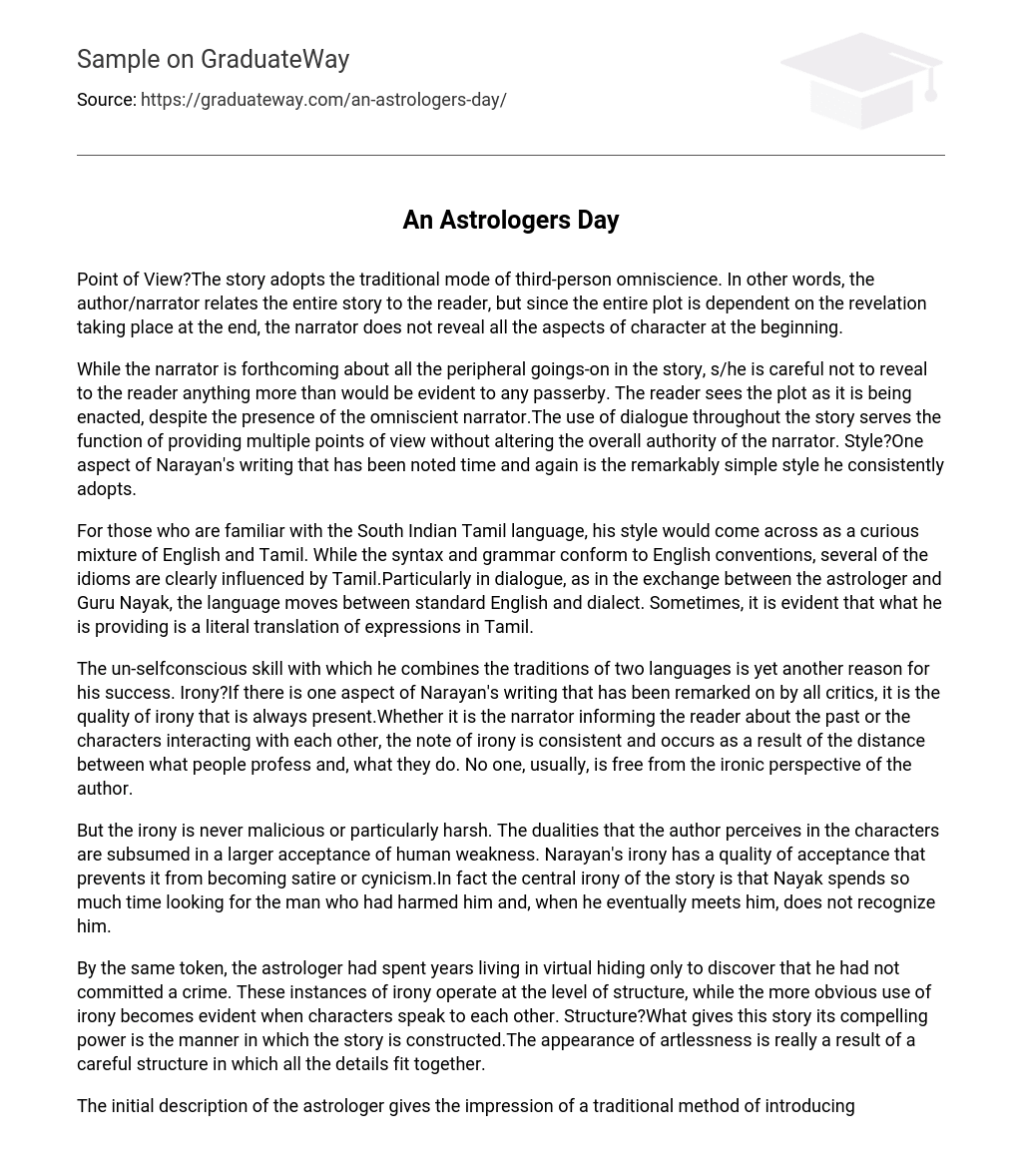The text describes the story’s narration style, which is a third-person omniscient point of view. The author/narrator follows a traditional narrative approach and shares the entire plot with the reader. However, some details about the characters are kept hidden until the end to create an important revelation within the storyline.
Although the narrator discloses peripheral events in the story, they only reveal what would be visible to any casual observer. The plot unfolds before the reader’s eyes, even with an omniscient narrator present. Dialogue is used to present different perspectives without diminishing the narrator’s authority. A notable characteristic of Narayan’s writing is his consistently simple style.
If you know the South Indian Tamil language, you’ll notice that the writer’s style is a unique blend of English and Tamil. Although the sentence structure and grammar follow English rules, many idioms are clearly influenced by Tamil. This is especially evident in dialogues, like the conversation between the astrologer and Guru Nayak, where the language alternates between standard English and dialect. At times, it’s clear that the writer is directly translating Tamil expressions into English.
The seamless blend of two languages is one of the significant factors contributing to his success. Is it ironic? The quality of irony is a notable aspect in Narayan’s writing, as acknowledged by all critics. Whether it’s the narrator narrating the past or the characters’ interactions, irony pervades consistently as a consequence of the contrast between words and actions. Rarely does anyone escape the author’s ironic viewpoint.
Despite the author’s broad understanding of human flaws, their irony remains non-malicious and not excessively harsh. The irony displayed by Narayan is characterized by acceptance rather than satire or cynicism. Interestingly, despite spending a considerable amount of time searching for the person who caused harm to Nayak, he ironically fails to identify them when they finally meet.
The astrologer, who had been in hiding for a considerable period, realizes that he is innocent. The story’s irony is apparent both in its structure and the conversations between the characters. This tale enthralls readers with its skillful arrangement, meticulously organizing every element to deliver a flawless portrayal.
The astrologer’s initial description creates the impression of a traditional character introduction through physical appearance. However, in this case, the astrologer’s appearance serves as a disguise rather than indicating that he is a fugitive. His profession requires him to convey the image of possessing mystical powers. Thus, he appears significantly different from the ordinary villager he used to be, making it understandable why Nayak fails to recognize him.
To explain why the astrologer initially fails to identify Nayak, a context is needed. This is accomplished by having Nayak appear when the light is very dim and the astrologer is about to close his shop for the day. It is important to note that the astrologer recognizes Nayak when he lights a cigar and his face briefly becomes illuminated. Likewise, seemingly insignificant observations gain importance later in the story.
The astrologer’s departure from the village is casually mentioned in the story, using a literary technique of foreshadowing. The author introduces a seemingly insignificant detail that later becomes significant. The relevance of the astrologer’s decision is revealed at the end when he admits he is a fugitive. Narayan’s unique writing style often situates his stories in the imaginary town of Malgudi.
Despite the possibility of speculating on a specific place for this city, the truth remains that Narayan intended Malgudi to represent India as a whole. The landscape and characters within it serve as strong allegories. The mountains, rivers, houses, city offices, places of worship, and shops are all designed in a way that implies Malgudi is a city that could exist anywhere in India. Narayan’s insistence on this concept gives his work a timeless quality.
R. K. Narayan, hailing from Madras, South India in 1907, was a member of the Brahmin caste, which is recognized as a Hindu priestly caste and has a rich literary background. As part of his Hinduism education, he acquired knowledge in both Sanskrit and English while Tamil continued to be his mother tongue, spoken by more than sixty million individuals in India.
Narayan’s first novel (in English) was published in 1935, during the division of India. He wrote retellings of classical Hindu myths and tales, as well as essays, short stories, and novels. Unlike some other Indian writers in the 20th century, Narayan openly addressed the political and economic upheaval happening in his society. However, he still focused on depicting the everyday lives of ordinary people in India. Through these portrayals, Narayan’s work becomes timeless and captures the transformative forces shaping India.
Narayan’s work has gained worldwide recognition, with critics admiring his depiction of Indian life as genuine, describing it as a combination of Hindu mysticism and English style. Despite being in English, Narayan’s work reflects a Hindu perspective and a belief that human experiences and difficulties are connected to a broader cosmic order.





